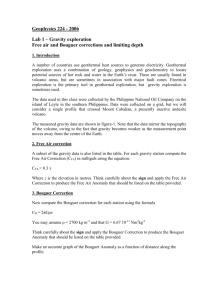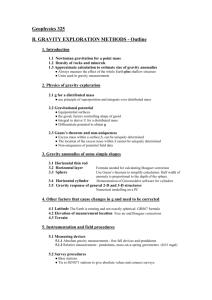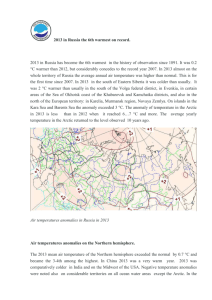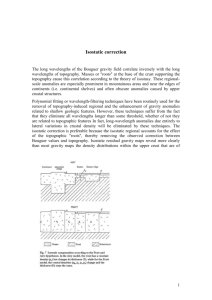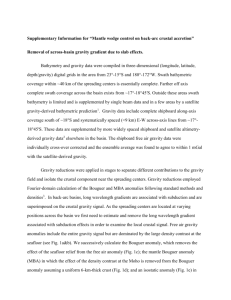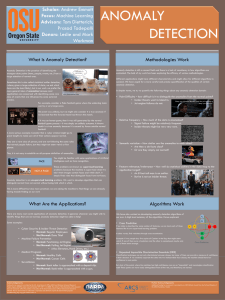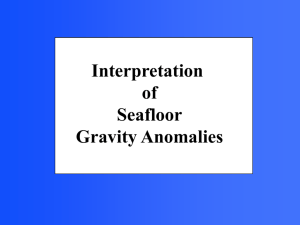Preparation of Gravity Anomaly Maps and Their Interpretations in
advertisement
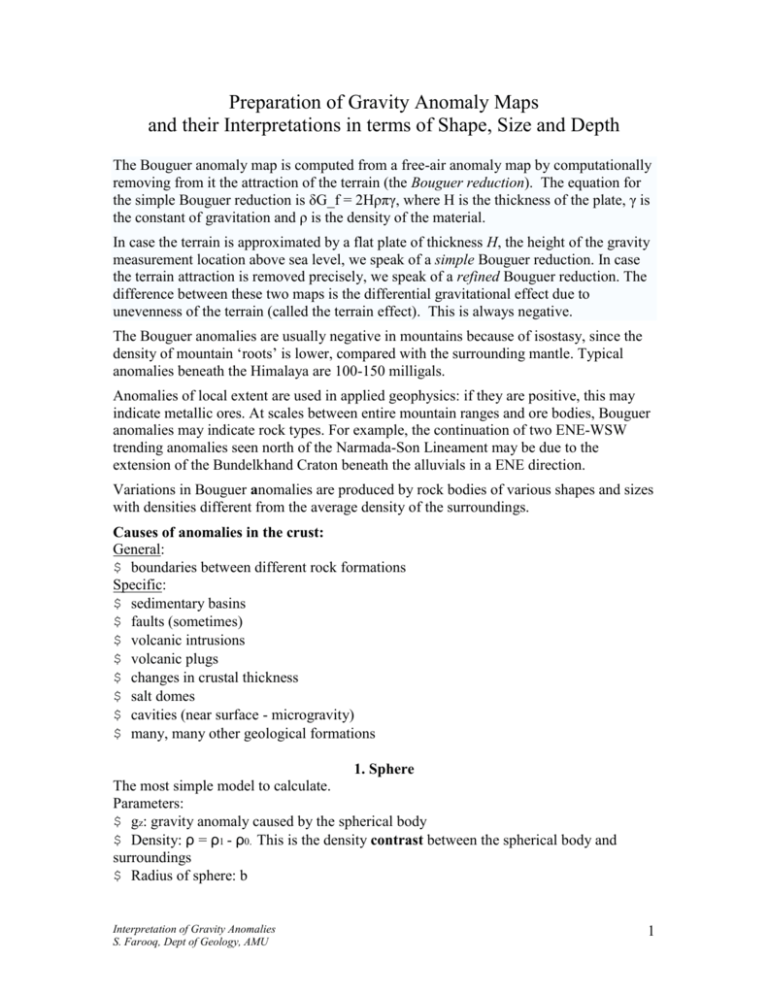
Preparation of Gravity Anomaly Maps and their Interpretations in terms of Shape, Size and Depth The Bouguer anomaly map is computed from a free-air anomaly map by computationally removing from it the attraction of the terrain (the Bouguer reduction). The equation for the simple Bouguer reduction is δG_f = 2Hρπγ, where H is the thickness of the plate, γ is the constant of gravitation and ρ is the density of the material. In case the terrain is approximated by a flat plate of thickness H, the height of the gravity measurement location above sea level, we speak of a simple Bouguer reduction. In case the terrain attraction is removed precisely, we speak of a refined Bouguer reduction. The difference between these two maps is the differential gravitational effect due to unevenness of the terrain (called the terrain effect). This is always negative. The Bouguer anomalies are usually negative in mountains because of isostasy, since the density of mountain ‘roots’ is lower, compared with the surrounding mantle. Typical anomalies beneath the Himalaya are 100-150 milligals. Anomalies of local extent are used in applied geophysics: if they are positive, this may indicate metallic ores. At scales between entire mountain ranges and ore bodies, Bouguer anomalies may indicate rock types. For example, the continuation of two ENE-WSW trending anomalies seen north of the Narmada-Son Lineament may be due to the extension of the Bundelkhand Craton beneath the alluvials in a ENE direction. Variations in Bouguer anomalies are produced by rock bodies of various shapes and sizes with densities different from the average density of the surroundings. Causes of anomalies in the crust: General: $ boundaries between different rock formations Specific: $ sedimentary basins $ faults (sometimes) $ volcanic intrusions $ volcanic plugs $ changes in crustal thickness $ salt domes $ cavities (near surface - microgravity) $ many, many other geological formations 1. Sphere The most simple model to calculate. Parameters: $ gz: gravity anomaly caused by the spherical body $ Density: ρ = ρ1 - ρ0. This is the density contrast between the spherical body and surroundings $ Radius of sphere: b Interpretation of Gravity Anomalies S. Farooq, Dept of Geology, AMU 1 $ Depth to centre of sphere, h $ Distance from point on surface directly above sphere, x Anomaly caused by buried sphere: Can be applied to: $ Volcanic intrusions $ Salt domes $ near surface cavities $ ... basically all situations where a near-spherical shape can be assumed for a geological feature 2. Infinite plate This is the same model as used in the Bouguer correction, with the anomaly calculated by: gz = 2πGρz $ gz gravity anomaly caused by plate $ ρ: density contrast between plate and surroundings $ z: thickness of plate Interpretation of Gravity Anomalies S. Farooq, Dept of Geology, AMU 2 Note that because the plate is infinite, the depth to its top does not affect gz. This model works surprisingly well for all bodies that are very wide compared to their thickness and depth to their top. Can be applied to: $ sedimentary basins $ almost all flat + wide bodies $ gives crude results Regional - residual anomaly separation Bouguer anomaly maps - the net sum of anomalies caused by all sources underlying the area which the map covers Total Bouguer anomaly: $ main trend of gravity field + $ one or several fluctuations from the main trend Main trend $ regional anomaly Variations $ local anomalies Figure shows example of separation of regional and local gravity field $ local = total - regional $ regional field: deep sources $ local field: shallow-local source Effect of depth of source on anomaly As the depth to the source gets greater, the more ambiguous the interpretation gets Any of the three bodies in c) is a potential source for the anomaly Interpretation of Gravity Anomalies S. Farooq, Dept of Geology, AMU 3 Interpretation of Gravity Anomalies S. Farooq, Dept of Geology, AMU 4
